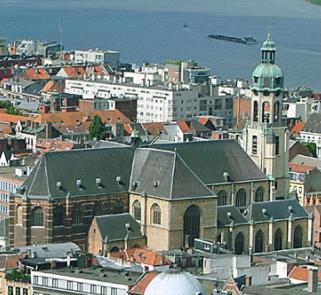Saint Andrew's Church Antwerp

Saint Andrew's Church Antwerp
Waaistraat 5
B-2000 Antwerp
Belgium
P 0032 (0)3 232 03 84
The history of the Saint Andrew's Church commences with the shortlived residence of the Augustinians at the beginning of the 16th century. Around 1512, they acquired a spacious plot of land for the construction of a monastery located close to Boeksteeg (now Nationalestraat). Owing to their popularity, the fathers were soon able to enlarge their monastery church into an actual one. However, because of their Lutheran symphathies, they were driven out by the Holy Roman Emperor, Charles V, in 1522. Three of them were even put to death and thus entered into history as the first martyrs of Protestantism. Completion of the church was made possible thanks to the sale of the monastery's grounds, and in 1529 it was consecrated as a parish church.
Side aisles and a tower were added subsequently, but at the time of the Second Iconoclastic Fury (1581), under the Calvinist administation, the chancel and the transept were razed to the ground. It was the case that the Calivinists were content simply to use the main aisle of the church as a rectangular auditorium around the pulpit. It was only at the end of the 17th century that the transept and chancel were rebuilt in the Gothic style and expanded with both side chapels.
As a result of the Iconoclastic Fury of 1566 and the Calvinist administration (1577-1585), nothing remains of the older, late-Gothic or Renaissance works of art. Immediately after the recapture of Antwerp by the Spanish powers in 1585, work began on reconstruction of the altars in the Mannerist style. Nevertheless, the furnishings and interior decoration of this Gothic church date largely from the baroque period, such as both of the uniquely preserved pillar altars with marble altar rail.
In the 17th century, it would appear that the preference was to entrust local artists from the parish with commissions for Saint Andrew's Church. Parishioners included the painters Franckens (Franckenstraat), Marten Pepijn, Erasmus Quellinus II, a churchwarden, and his son Jan Erasmus Quellinus. The life-size Saint Peter, one of Belgium's most beautiful baroque marble sculptures, similarly owes itself to a local parshioner, Artus Quellinus I, ‘sculptor of the Amsterdam Town Hall' which, following his funeral here, is how he had himself commemorated on his memorial stone at the Franciscans' church in Antwerp (now destroyed).
The fact that no commissions were given to Peter Paul Rubens, who lived in the parish for a number of years, is simply due to the fact that the altars in Saint Andrew's had, before his return from Italy in 1608, only just been redecorated by other modern masters, such as Otto Van Veen and Maerten De Vos. However, can there be any doubt that the grand master of Flemish baroque painting had some hand in the great altarpiece that was produced by his then tutor and partner, Van Veen, just before Rubens' departure for Italy? However it may be, the intended examination of The Martyrdom of Saint Andrew seems promising, especially following the acquisition of Van Veen's modello (detailed sketch) in 2006.
Due to the late expansion of the church and due to its lack of an authentic Rubens' painting, Saint Andrew's Church was not considered worthy of note in the baroque period. Consequently, there was no familiarity with any of its interior features. Much more commonly portrayed is the former tower of the Saint Andrew's Church with its Renaissance, pear-shaped pinnacle. However, following its collapse in 1755, the old Saint Andrew's tower was replaced with a new one in a late-baroque style, so it is barely recognisable from 17th-century views of the city.
CC BY (Creative Commons 4.0)
